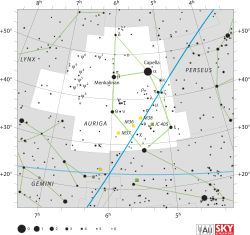Lambda Aurigae
| Lambda Aurigae (λ) | |
 | |
| Observationsdata Epok: J2000.0 | |
|---|---|
| Stjärnbild | Kusken |
| Rektascension | 05t 19m 08,47420s[1] |
| Deklination | +40° 05′ 56,5826″[1] |
| Skenbar magnitud () | +4,71[2] |
| Stjärntyp | |
| Spektraltyp | G1 V[3] |
| U–B | +0,13[2] |
| B–V | +0,62[2] |
| Astrometri | |
| Radialhastighet () | +66,5[4] km/s |
| Egenrörelse (µ) | RA: + 518,99 ± 0,26[1] mas/år Dek.: -665,06 ± 0,13[1] mas/år |
| Parallax () | 79,17 ± 0,28[1] |
| Avstånd | 41,2 ± 0,1 lå (12,63 ± 0,04 pc) |
| Absolut magnitud () | +4,20[5] |
| Detaljer | |
| Massa | 1,081 +0,054-0,029[6] M☉ |
| Radie | 1,331 ± 0,021[3] R☉ |
| Luminositet | 1,732 ± 0,022[3] L☉ |
| Temperatur | 5 890 ± 4,3[7] K |
| Metallicitet | +0,12[8] dex |
| Vinkelhastighet | 2[9] km/s |
| Ålder | 4[8] 5,0-7,9 [10] miljarder år |
| Andra beteckningar | |
| 15 Aurigae, BD+39° 1248, FK5 1145, GJ 197, HD 34411, HIP 24813, HR 1729, LFT 403, LHS 1753, LTT 11625, SAO 40233. [11] | |
Lambda Aurigae (λ Aurigae, förkortat Lambda Aur, λ Aur) som är stjärnans Bayerbeteckning, är en solliknande stjärna[8] belägen i den mellersta delen av stjärnbilden Kusken. Den har en skenbar magnitud på 4,71[2] och är synlig för blotta ögat där ljusföroreningar ej förekommer. Baserat på parallaxmätning inom Hipparcosuppdraget på ca 79,2[1] mas, beräknas den befinna sig på ett avstånd på ca 41 ljusår (ca 13 parsek) från solen.
Nomenklatur[redigera | redigera wikitext]
Lambda Aurigae kan ha haft namnet Al Hurr, vilket betyder fjäskaren på arabiska.[12] Den var tillsammans med μ Aur och ρ Aur Kazwini's Al Ḣibā' ( ألحباع ), tältet.[12] Enligt stjärnkatalogen i det tekniska memorandumet 33-507 - A Reduced Star Catalog Containing 537 Named Stars var Al Ḣibā namnet på tre stjärnor: λ Aur som Al Ḣibā' I, μ Aur som Al Ḣibā' II och ρ Aur som Al Ḣibā' III.[13]
Egenskaper[redigera | redigera wikitext]
Lambda Aurigae är en gul till vit stjärna i huvudserien av spektralklass G1 V[3] med en komposition liknande solens.[14] Den har en massa som är ca 10[6] procent större än solens massa, en radie som är ca 1,3[3] gånger större än solens och utsänder från dess fotosfär ca 1,7[3] gånger mera energi än solen vid en effektiv temperatur på ca 5 890[7] K.
Lambda Aurigae har undersökts för förekomst av överskott på infraröd strålning, som kan tyda på förekomst av en omgivande stoftskiva, men inget signifikant överskott har observerats.[8] Den är en möjlig medlem av Epsilon Indi Moving Group av stjärnor som delar en gemensam rörelse genom rymden.
Källor[redigera | redigera wikitext]
- Den här artikeln är helt eller delvis baserad på material från engelskspråkiga Wikipedia, tidigare version.
Referenser[redigera | redigera wikitext]
- ^ [a b c d e f] van Leeuwen, Floor (November 2007), "Validation of the new Hipparcos reduction", Astronomy and Astrophysics, 474 (2): 653–664, arXiv:0708.1752v1 , Bibcode:2007A&A...474..653V, doi:10.1051/0004-6361:20078357. Note: see VizieR catalogue I/311.
- ^ [a b c d] Johnson, H. L.; et al. (1966), "UBVRIJKL photometry of the bright stars", Communications of the Lunar and Planetary Laboratory, 4 (99), Bibcode:1966CoLPL...4...99J.
- ^ [a b c d e f] Boyajian, Tabetha S.; et al. (February 2012), "Stellar Diameters and Temperatures. I. Main-sequence A, F, and G Stars", The Astrophysical Journal, 746 (1): 101, arXiv:1112.3316 , Bibcode:2012ApJ...746..101B, doi:10.1088/0004-637X/746/1/101.. See Table 10.
- ^ Nordström, B.; et al. (May 2004), "The Geneva-Copenhagen survey of the Solar neighbourhood. Ages, metallicities, and kinematic properties of ˜14 000 F and G dwarfs", Astronomy and Astrophysics, 418: 989–1019, arXiv:astro-ph/0405198 , Bibcode:2004A&A...418..989N, doi:10.1051/0004-6361:20035959.
- ^ Holmberg, J.; et al. (July 2009), "The Geneva-Copenhagen survey of the solar neighbourhood. III. Improved distances, ages, and kinematics", Astronomy and Astrophysics, 501 (3): 941–947, arXiv:0811.3982 , Bibcode:2009A&A...501..941H, doi:10.1051/0004-6361/200811191.
- ^ [a b] Takeda, Genya; et al. (February 2007), "Structure and Evolution of Nearby Stars with Planets. II. Physical Properties of ~1000 Cool Stars from the SPOCS Catalog", The Astrophysical Journal Supplement Series, 168 (2): 297–318, arXiv:astro-ph/0607235 , Bibcode:2007ApJS..168..297T, doi:10.1086/509763.
- ^ [a b] Kovtyukh, V. V.; et al. (2003), "High precision effective temperatures for 181 F-K dwarfs from line-depth ratios", Astronomy and Astrophysics, 411 (3): 559–564, arXiv:astro-ph/0308429 , Bibcode:2003A&A...411..559K, doi:10.1051/0004-6361:20031378.
- ^ [a b c d] Greaves, J. S.; Wyatt, M. C.; Bryden, G. (August 2009), "Debris discs around nearby solar analogues", Monthly Notices of the Royal Astronomical Society, 397 (2): 757–762, arXiv:0907.3677 , Bibcode:2009MNRAS.397..757G, doi:10.1111/j.1365-2966.2009.15048.x.
- ^ Takeda, Yoichi; et al. (February 2005), "High-Dispersion Spectra Collection of Nearby F--K Stars at Okayama Astrophysical Observatory: A Basis for Spectroscopic Abundance Standards", Publications of the Astronomical Society of Japan, 57 (1): 13–25, Bibcode:2005PASJ...57...13T, doi:10.1093/pasj/57.1.13.
- ^ Mamajek, Eric E.; Hillenbrand, Lynne A. (November 2008), "Improved Age Estimation for Solar-Type Dwarfs Using Activity-Rotation Diagnostics", The Astrophysical Journal, 687 (2): 1264–1293, arXiv:0807.1686 , Bibcode:2008ApJ...687.1264M, doi:10.1086/591785.
- ^ "lam Aur". SIMBAD. Centre de données astronomiques de Strasbourg. Hämtad 2012-08-19.
- ^ [a b] Allen, R. H. (1963). Star Names: Their Lore and Meaning (Reprint ed.). New York, NY: Dover Publications Inc. p. 91. ISBN 0-486-21079-0. Hämtad 2010-12-12.
- ^ Rhoads, Jack W. (November 15, 1971), Technical Memorandum 33-507-A Reduced Star Catalog Containing 537 Named Stars (PDF), California Institute of Technology: Jet Propulsion Laboratory, hämtad 2012-08-19.
- ^ Chen, Y. Q.; et al. (February 2000), "Chemical composition of 90 F and G disk dwarfs", Astronomy and Astrophysics Supplement, 141: 491–506, arXiv:astro-ph/9912342 , Bibcode:2000A&AS..141..491C, doi:10.1051/aas:2000124.





